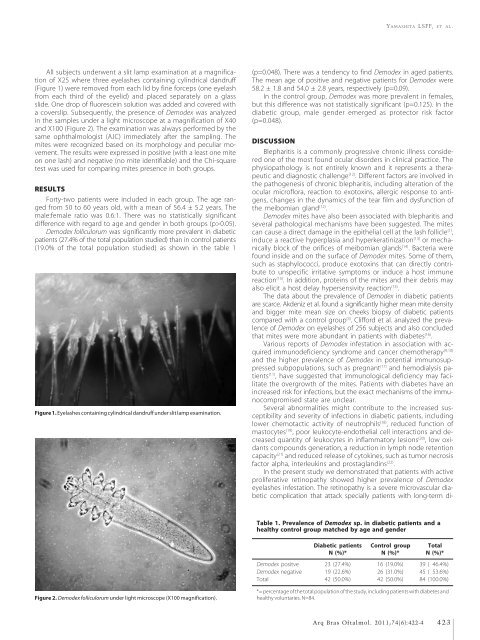Cost and effectiveness of non-penetrating deep sclerectomy ...
Cost and effectiveness of non-penetrating deep sclerectomy ...
Cost and effectiveness of non-penetrating deep sclerectomy ...
You also want an ePaper? Increase the reach of your titles
YUMPU automatically turns print PDFs into web optimized ePapers that Google loves.
YAMASHITA LSFF, ET AL.<br />
All subjects underwent a slit lamp examination at a magnification<br />
<strong>of</strong> X25 where three eyelashes containing cylindrical d<strong>and</strong>ruff<br />
(Figure 1) were removed from each lid by fine forceps (one eyelash<br />
from each third <strong>of</strong> the eyelid) <strong>and</strong> placed separately on a glass<br />
slide. One drop <strong>of</strong> fluorescein solution was added <strong>and</strong> covered with<br />
a coverslip. Subsequently, the presence <strong>of</strong> Demodex was analyzed<br />
in the samples under a light microscope at a magnification <strong>of</strong> X40<br />
<strong>and</strong> X100 (Figure 2). The examination was always performed by the<br />
same ophthalmologist (AJC) immediately after the sampling. The<br />
mites were recognized based on its morphology <strong>and</strong> peculiar movement.<br />
The results were expressed in positive (with a least one mite<br />
on one lash) <strong>and</strong> negative (no mite identifiable) <strong>and</strong> the Chi-square<br />
test was used for comparing mites presence in both groups.<br />
RESULTS<br />
Forty-two patients were included in each group. The age ranged<br />
from 50 to 60 years old, with a mean <strong>of</strong> 56.4 ± 5.2 years. The<br />
male:female ratio was 0.6:1. There was no statistically significant<br />
difference with regard to age <strong>and</strong> gender in both groups (p>0.05).<br />
Demodex folliculorum was significantly more prevalent in diabetic<br />
patients (27.4% <strong>of</strong> the total population studied) than in control patients<br />
(19.0% <strong>of</strong> the total population studied) as shown in the table 1<br />
Figure 1. Eyelashes containing cylindrical d<strong>and</strong>ruff under slit lamp examination.<br />
(p=0.048). There was a tendency to find Demodex in aged patients.<br />
The mean age <strong>of</strong> positive <strong>and</strong> negative patients for Demodex were<br />
58.2 ± 1.8 <strong>and</strong> 54.0 ± 2.8 years, respectively (p=0.09).<br />
In the control group, Demodex was more prevalent in females,<br />
but this difference was not statistically significant (p=0.125). In the<br />
diabetic group, male gender emerged as protector risk factor<br />
(p=0.048).<br />
DISCUSSION<br />
Blepharitis is a commonly progressive chronic illness considered<br />
one <strong>of</strong> the most found ocular disorders in clinical practice. The<br />
physiopathology is not entirely known <strong>and</strong> it represents a therapeutic<br />
<strong>and</strong> diagnostic challenge (12) . Different factors are involved in<br />
the pathogenesis <strong>of</strong> chronic blepharitis, including alteration <strong>of</strong> the<br />
ocular micr<strong>of</strong>lora, reaction to exotoxins, allergic response to antigens,<br />
changes in the dynamics <strong>of</strong> the tear film <strong>and</strong> dysfunction <strong>of</strong><br />
the meibomian gl<strong>and</strong> (12) .<br />
Demodex mites have also been associated with blepharitis <strong>and</strong><br />
several pathological mechanisms have been suggested. The mites<br />
can cause a direct damage in the epithelial cell at the lash follicle (1) ,<br />
induce a reactive hyperplasia <strong>and</strong> hyperkeratinization (13) or mechanically<br />
block <strong>of</strong> the orifices <strong>of</strong> meibomian gl<strong>and</strong>s (14) . Bacteria were<br />
found inside <strong>and</strong> on the surface <strong>of</strong> Demodex mites. Some <strong>of</strong> them,<br />
such as staphylococci, produce exotoxins that can directly contribute<br />
to unspecific irritative symptoms or induce a host immune<br />
reaction (15) . In addition, proteins <strong>of</strong> the mites <strong>and</strong> their debris may<br />
also elicit a host delay hypersensivity reaction (13) .<br />
The data about the prevalence <strong>of</strong> Demodex in diabetic patients<br />
are scarce. Akdeniz et al. found a significantly higher mean mite density<br />
<strong>and</strong> bigger mite mean size on cheeks biopsy <strong>of</strong> diabetic patients<br />
compared with a control group (3) . Clifford et al. analyzed the prevalence<br />
<strong>of</strong> Demodex on eyelashes <strong>of</strong> 256 subjects <strong>and</strong> also concluded<br />
that mites were more abundant in patients with diabetes (16) .<br />
Various reports <strong>of</strong> Demodex infestation in association with acquired<br />
immunodeficiency syndrome <strong>and</strong> cancer chemotherapy (9,10)<br />
<strong>and</strong> the higher prevalence <strong>of</strong> Demodex in potential immunosuppressed<br />
subpopulations, such as pregnant (17) <strong>and</strong> hemodialysis patients<br />
(11) , have suggested that immunological deficiency may facilitate<br />
the overgrowth <strong>of</strong> the mites. Patients with diabetes have an<br />
increased risk for infections, but the exact mechanisms <strong>of</strong> the immunocompromised<br />
state are unclear.<br />
Several abnormalities might contribute to the increased susceptibility<br />
<strong>and</strong> severity <strong>of</strong> infections in diabetic patients, including<br />
lower chemotactic activity <strong>of</strong> neutrophils (18) , reduced function <strong>of</strong><br />
mastocytes (19) , poor leukocyte-endothelial cell interactions <strong>and</strong> decreased<br />
quantity <strong>of</strong> leukocytes in inflammatory lesions (20) , low oxidants<br />
compounds generation, a reduction in lymph node retention<br />
capacity (21) <strong>and</strong> reduced release <strong>of</strong> cytokines, such as tumor necrosis<br />
factor alpha, interleukins <strong>and</strong> prostagl<strong>and</strong>ins (22) .<br />
In the present study we demonstrated that patients with active<br />
proliferative retinopathy showed higher prevalence <strong>of</strong> Demodex<br />
eyelashes infestation. The retinopathy is a severe microvascular diabetic<br />
complication that attack specially patients with long-term di-<br />
Table 1. Prevalence <strong>of</strong> Demodex sp. in diabetic patients <strong>and</strong> a<br />
healthy control group matched by age <strong>and</strong> gender<br />
Diabetic patients Control group Total<br />
N (%)* N (%)* N (%)*<br />
Demodex positve 23 (27.4%) 16 (19.0%) 39 (046.4%)<br />
Demodex negative 19 (22.6%) 26 (31.0%) 45 (053.6%)<br />
Total 42 (50.0%) 42 (50.0%) 84 (100.0%)<br />
Figure 2. Demodex folliculorum under light microscope (X100 magnification).<br />
*= percentage <strong>of</strong> the total population <strong>of</strong> the study, including patients with diabetes <strong>and</strong><br />
healthy voluntaries. N=84.<br />
Arq Bras Oftalmol. 2011;74(6):422-4<br />
423

















